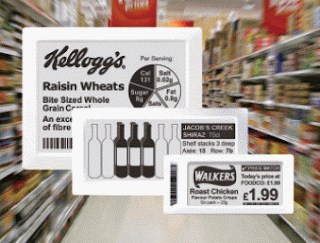The Future of Retailing:
Shelf Revolution:
Consumers are accustomed to seeing paper labels displaying pricing and product information at the shelf edge. But do they provide the information needed to aid in the buying decision? NO.
By eliminating paper completely, and providing unlimited control of what info and messages are shown to the customers, electronic paper displays such as ZBD’s epops (electronic point of purchase), are the next generation of "price tags."
ZBD’s epops replace paper displays with fully graphical, high-resolution displays, that are capable of showing logos, images, nutritional information, pricing and competitor pricing. ZBD’s epaper displays enable the retailer to deliver any content to the point of purchase, any time and combine the benefits of paper with the dynamism of displays.
http://www.retailtechnology.co.uk/cover-stories/new-shelf-edge-convention
RFIDs (Radio Frequency Identification Devices)
The next big thing in the way we shop is on its way to the spotlight. Enter Radio Frequency Identification Devices, or RFIDs. They are tiny microchips with an antenna, and they are the next step after barcodes, which is what retailers currently use to manage inventory and stop theft. Rather than the barcode however, retailers can manage their inventory remotely, meaning no longer do employees have to handle the products personally, they can do it all from the back room. They can also be used to trigger promotional messages when you pick up a product in store. In the future RFID readers could scan your bags as you leave a store and automatically take the money from a suitably enabled mobile phone which is linked to your bank or credit card.
http://toptrends.nowandnext.com/2006/09/15/rfid/
PA
PRADA, NYC
The Prada store located in Manhattan's SoHo district offers one of the most technologically advanced shopping experiences. There are video monitors that hang from racks or are embedded in tables. An alcove at the back of the basement level is lined with small video monitors playing a steady stream of random clips. A large round, glass enclosed elevator that shuttles customers between the ground floor and basement level. The dressing rooms feature clear glass that turns opaque when you step on a round black button on the floor. If you want to try on your suit, you enter one of these high-tech dressing rooms and hang it in the smart closet. The closet reads the RFID tag and displays information about the suit on a liquid crystal touch screen. You can through through accessories or see the same item in different colors. The content displayed is all related to the item in the closet, part of the same line or look in Prada's inventory. The sales associate can use the screen to up-sell by showing you items that might go well with your suit.
http://www.rfidjournal.com/article/view/272/3














